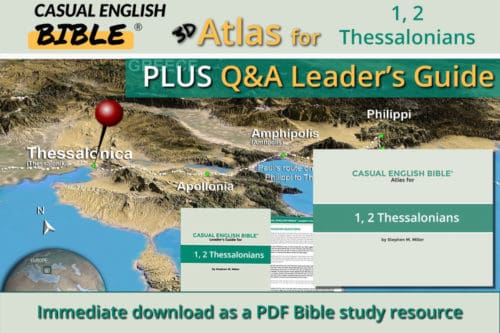Description
Preview
What you get:
- Tips for teaching Hebrews in a Bible study
- Over about 80 discussion questions WITH answers
- Atlas of 15 high-resolution maps about stories in Hebrews
- 50 PDF pages of resources
- 2 Versions: high-resolution; optimized for mobile devices
Sample map in Hebrews Leaders Guide & Atlas

Good Jews belong in church
Good Jews belong in church. That’s the letter of Hebrews in a sentence.
Scholars can only guess
—who wrote this elegant letter,
—when they wrote it,
—and to whom they wrote it.
But why was it written? That’s easy enough, most scholars seem to agree.
Jewish Christians somewhere in the Mediterranean world were apparently leaving the church and returning to the synagogue. They were trading in Christianity for the Jewish faith.
Christianity wasn’t safe. Judaism was, since it was protected under Roman law.
Jewish Christians were under attack. They were persecuted as blasphemers and heretics by their fellow Jews. They were arrested by Romans as troublemakers whose oddball religion sparked riots. Romans started executing Christians after Emperor Nero blamed them for burning most of Rome in AD 64.
Jewish Christians were feeling the heat. They “weathered a terrible storm of hardship and suffering” (10:32). Apparently, some had already left the church and others were considering it.
It’s too late, the Hebrews writer says. The Jewish religion as it existed before Jesus is gone—replaced, as God said it would be.
Half a millennium earlier, God had promised to replace the contract agreement he made with the Jewish people—an ancient contract was based on laws they were to obey.
“This is the agreement I’ll make with the people when the time comes.
I’m going to write my laws onto their hearts.
I’m going to embed them into their minds” (Hebrews 10:16).
There was nothing for Jewish Christians to go back to but the ruins of an obsolete faith.
The writer makes that point every which way to Sunday. Some of his arguments relentlessly beat that nail like a hammer. He does that when he works his way through the human history to show that what God really wants from people is faith, not the animal sacrifices that Jews offer.
Some of his arguments would make no sense to many folks today. The weirdest shows up when he says Levi (father of the tribe that produced Israel’s priests) gave a tithe to the mysterious king and priest known as Melchizedek. It was Abraham who gave the tithe, but the writer says Levi was there, too: “After all, Levi was in his father’s body at the time, though unborn” (Hebrews 7:10).
Well, that’s a stretch. Abraham was Levi’s great-grandfather. Levi wouldn’t become a swimmer in his father’s pool for quite some time. Decades at least.
Creative interpretations of the Bible were welcome in early centuries of Christianity and in Judaism at the time. Often, symbolic approaches like this were valued above the more obvious and literal understanding.
Sometimes, the writer of Hebrews plays the good cop. “Let’s think about how we can encourage each other to be loving and to do kind things for others” (Hebrews 10:24).
Sometimes, the bad cop. “You don’t seem to pay attention. You’re catching on at the pace of a slug… Doggone if you aren’t spiritual babies who still need to suck milk” (Hebrews 5:11-12).
The Hebrews writer attacked the problem from a dizzying array of angles, apparently hoping that if one argument didn’t strike the heart of a backsliding believer, another angle would.
In addition to Hebrews Leaders Guide & Atlas
You might consider the Leviticus Leaders Guide & Atlas
Best resource for comparing other Bible translations: Bible Gateway. This isn’t an ad. It’s a recommendation from the Casual English Bible.
To support the work of paraphrasing the Casual English Bible and keeping it free online:











